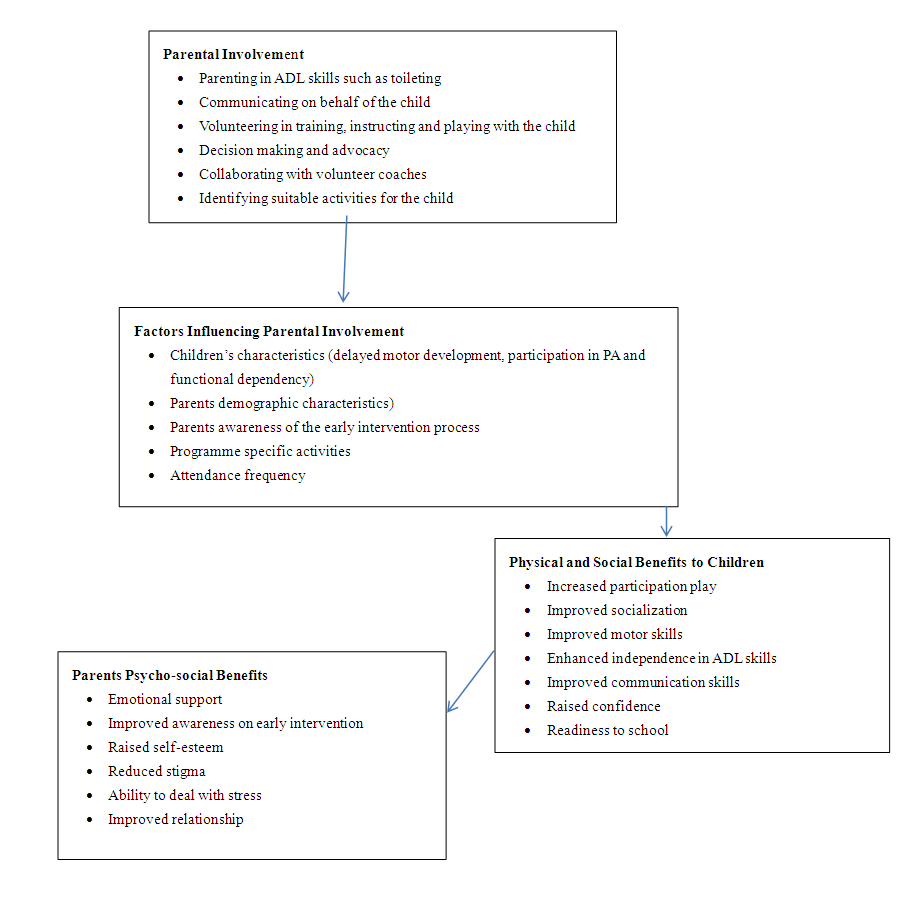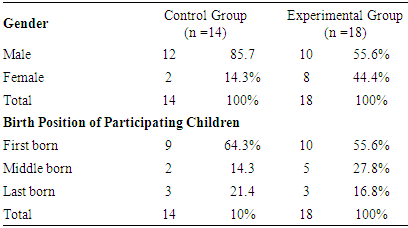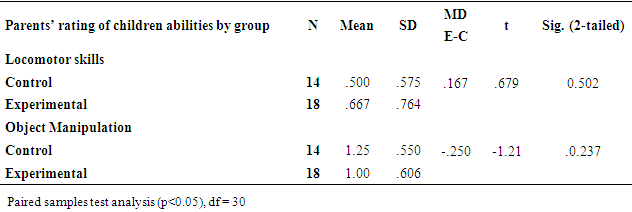-
Paper Information
- Next Paper
- Paper Submission
-
Journal Information
- About This Journal
- Editorial Board
- Current Issue
- Archive
- Author Guidelines
- Contact Us
International Journal of Sports Science
p-ISSN: 2169-8759 e-ISSN: 2169-8791
2020; 10(3): 62-67
doi:10.5923/j.sports.20201003.02

Motor Abilities of Children with Intellectual Disability Participating in Organized Physical Activity Programme in Nairobi County, Kenya
Jane W. Mwangi1, Andanje Mwisukha1, Peter W. Bukhala2
1Department of Physical Education, Exercise and Sport Science, Kenyatta University, Kenya
2Department of Health Promotion and Sports Science, Masinde Muliro University of Science and Technology, Kenya
Correspondence to: Jane W. Mwangi, Department of Physical Education, Exercise and Sport Science, Kenyatta University, Kenya.
| Email: |  |
Copyright © 2020 The Author(s). Published by Scientific & Academic Publishing.
This work is licensed under the Creative Commons Attribution International License (CC BY).
http://creativecommons.org/licenses/by/4.0/

Motor skills development and learning in children increase rapidly between two to six years of age, and parents play a critical role in identifying deficits caused by delayed motor development in these early years especially those with intellectual disability. Therefore, parents constitute an important link in the process of identifying and implementing suitable physical activities to address salient and intractable aspects in the development of their children. This study therefore, aimed at comparing parents’ ratings of the motor abilities of their children with ID of age 4-6 years before and after participating in eight weeks organized physical activity (PA) programme. Quasi-experimental non–equivalent control group research design was adopted for the study. The study targeted parents and their children with ID learning in the four inclusive Early Childhood Development (ECD) centres in Nairobi City County. However, only two ECD centres in Nairobi County that had the highest number of leaners with ID were purposively selected and then randomly assigned into experimental and control groups. The children’s parents/guardians were recruited in the study. In experimental group, 20 children and 20 parents met the inclusion and exclusion criteria while in the control group 17 children and 17 parents were included in the study, making a sample size of 74(80.4 %) out of the 92 total targeted population. A total of 62(83.8%) participants successfully completed the three-months PA programme. The test-retest was conducted to determine reliability of the research instrument. Parents’ ratings of their children’s motor abilities were collected using a self-administered questionnaire. Data was coded and organized for analysis using the Statistical Package for Social Sciences (SPSS) version 20. Results on demographic characteristics of subjects showed that most of the parents involved were female 71.1% in control group and 100% female in the experimental group while most children participants were male 85.7%. Independent t-tests showed significant difference after intervention in terms of parents’ ratings of their children’s motor performance in control group t(13)= -3.37, p<0.001 and experimental group t(17)= -7.402, p<0.001. It can be concluded that participating in in organized PA greatly improved children’s motor skill performance. The change was more in the experimental group where children with ID and parents participated in the PA jointly. Initiating organized adapted PA programmes for children with ID early enough, training parents and encouraging more parental involvement is recommended. The study recommends that researchers examine levels of awareness of PA as a method of early intervention strategy among children with ID.
Keywords: Motor abilities, Participation in organized physical activity, Children with intellectual disability, Parental Involvement, Parent’s Rating
Cite this paper: Jane W. Mwangi, Andanje Mwisukha, Peter W. Bukhala, Motor Abilities of Children with Intellectual Disability Participating in Organized Physical Activity Programme in Nairobi County, Kenya, International Journal of Sports Science, Vol. 10 No. 3, 2020, pp. 62-67. doi: 10.5923/j.sports.20201003.02.
Article Outline
1. Introduction
- Achievement of motor skill abilities is critical in the lifelong development of children in all aspects (Costello & Warne, 2020). The rate of attaining the motor skill abilities is influenced by nature of children (Bremer and Cairney, 2018). Assessment of children with ID has indicated that they have deficits in their physical, intellectual, personal communication, social development and feeling of powerlessness thus becoming so dependent on other people in their daily lives (Bianca, 2013). Success in developing sporting and athletic talents for children with intellectual disability (ID) may be influenced by appropriate early intervention physical activity programmes designed for motor skill stimulation. Early involvement of parents in structured and organized physical activity programmes may determine the performance outcomes in sports. The purpose of this study was to compare motor skill performance of children with ID of age 4-6 years before and after involvement together with their parents in an organized PA programme. Research supports parental involvement (PI) in early intervention programs for children with disability (Leeni & Karin, 2014). In early childhood, physical activities serve as the platform for the development of motor skills essential for performance of activities of daily living, interaction and education achievement (Desforges and Abouchaar, 2003). Herbert (2014) notes that parents play a major role in identifying intervention programmes for their children with disabilities. Motor skills development and learning in children increase rapidly within two to six years of age. Consequently, Muhammad, Tariq, Ashiq and Ahmed, 2011) indicate that early intervention approaches may take a process of involving parents in an organized physical activity (PA) program for their children with intellectual disability. During the study, children with intellectual disability were subjected to an eight-week organized physical activity progrmme. In the experimental group, parents directly participated in the organized programme together with their children with intellectual disability while those in the control group, parents were not directly involved. This study therefore, sought to establish parents’ ratings on motor skills performance for children with intellectual disability participating in an organized physical activity programme in Nairobi City County, Kenya.
2. Objective
- The objective that guided the study was comparing parents’ ratings of the motor abilities of their children with ID before and after participating in organized physical activity programme.
3. Conceptual Framework
- According to the theoretical model of Epstein (2005), in physical activity and sports in particular, parental involvement has enormous potential to positively influence their children and their role means much more than providing snacks and dropping them for practice. Epstein, Sanders, Simon, Salines, Johnson, & Voorhis (2002) and Sandeep (2017), further explains that parents are positive role models in physical activities that encourage their children to participate hence, impacting on the physical growth, motor skill and intellectual development, as well as directing their emotional behaviour. Children with intellectual disabilities may require the involvement of their parents as communication links to the instructors. This will enhance interaction with service providers who are involved in the important process of learning skills leading to the acceptance of the parties. Parents can be given opportunity to participate and volunteer in instructing their children. A conceptual framework based on Epstein Model on Parental Involvement (Epstein, Beniah, O’Here, Goll, & Tucks (2008) that includes parenting skills, communicating, volunteering, learning at home, decision-making and collaboration explains the relationship between parental involvement, children’s characteristic, role of parents and outcomes is shown in Figure 1 below.Conceptual Framework
 | Figure 1. Forces Shaping Parental Involvement in Organized Physical Activity Programme for Children with Intellectual Disability. (Source: Adapted from Epstein et.al (2008)) |
4. Research Design
- Quasi-experimental non-equivalent control group research design was adopted for the study. The design was found suitable for the study as it allowed for unequal control and experimental group to be compared (Schaw 2012). In this study the quasi experimental non-equivalent control group research design allowed the researcher to evaluate the responses from the non-equal number of parents and observations from the children in the experimental and control groups at two-time points then compare significant differences.
5. Study Participants
- The study participants were parents and their children with intellectual disability from two purposively selected inclusive early childhood education centers. The subjects from the two sites were then randomly selected into control group where children with ID took part in fun PA as their parents observed or left them and an experimental group, in which children participated together with their parents. Independent research variable was participation in organized physical activity programme while dependent variable was the motor abilities among children with ID participants. The study targeted parents and their children with ID of age 4–6 years. After recruitment, 37 children met the inclusion and exclusion criteria and their parents were recruited as subjects in the study. However, only 32 completed the study, an 86.4% return rate.
|
|
|
|
6. Discussion
- Results from the parents’ ratings that involved two subscales: child’s ability to perform locomotor activities and object manipulation skills showed high significant improvements both in the control and experimental groups. Further, magnitude of mean difference in parents’ ratings of their children’s motor abilities performance before and after participating in the organized PA showed a non-significant difference. Research studies on participation of children with disabilities outside of school revealed significant impact among children who participated in the community-based programmes and was positively correlated to increased quality of life (Tonkin et.al, 2014; Haibach et.al, 2011). This concur with the findings of the current study that engaged children with ID of 4-6 years of age, and showed great improvement in performing motor skills such as basic movements that included throwing, catching, hopping, striking, balancing running and jumping that formed a base for more complex sport-specific movement patterns attributed to the impact of participating in organized PA.
7. Motor Ability Performance
- The current study showed that parents’ ratings of their children’s motor abilities had greatly improved after participating in the organized PA programme. Zwolinska, Podstawki and Monosielska (2014) reveal that children developed fundamental motor skills at a differentiated manner and those with ID may require early intervention programmes in which adults are involved. In their study, they assessed children with ID of age 5-6 years attending therapy on development movement. Results indicated significant influence on motor skills improvement in children who were accompanied by adult special educators and concluded that children with ID can greatly improve in their motor skills abilities if given a chance to be a part of early intervention program. Karpljuk, Masleja and Videmek (2012) involved individuals with intellectual disability in an eight-week martial art training programme. Results of a t-test showed statistically significant differences between the initial and final measurements of seven subsets of motor abilities. The results concur with findings in the current study that assessed children with ID who participated in an organized PA, 4-6 years of age and their parents were asked to rate their motor abilities. Findings showed high significance difference (p<.05) in motor abilities after participating in the organized PA that were similar for both experimental groups, in which parents were directly involved in the activities and control group though parents were not directly involved. The results did not have significant magnitude of mean difference between control and experimental groups. This was an indication that the children with ID in the control and experimental groups received an equal guidance in organized programme of PA and the children had similar entry and exit behaviour.
8. Conclusions
- There was significant increase in motor ability performance after participating in the organized PA programme both in the experimental and the control group. Although mean differences were high among children with ID in the experimental group than those in the control group, this did not significantly differ in parents’ ratings of their children’s motor abilities. This was an indication that the groups of children with ID were homogeneous and equally benefited from the organized PA programme. However, cumulative mean scores were significantly higher among children with ID in the experimental group than those in the control. This was associated to parents in the experimental group participating in the organized physical activity programme together with their children. In addition, parents’ consistent involvement and supporting their children with ID to perform the physical activities may have contributed to the positive variance. The study recommends that parents to consistently identify suitable physical activities and sports that they can participate together with their children with intellectual disability. On further studies, researchers can examine levels of awareness of PA among as a method of early intervention strategy among children with ID.
 Abstract
Abstract Reference
Reference Full-Text PDF
Full-Text PDF Full-text HTML
Full-text HTML


